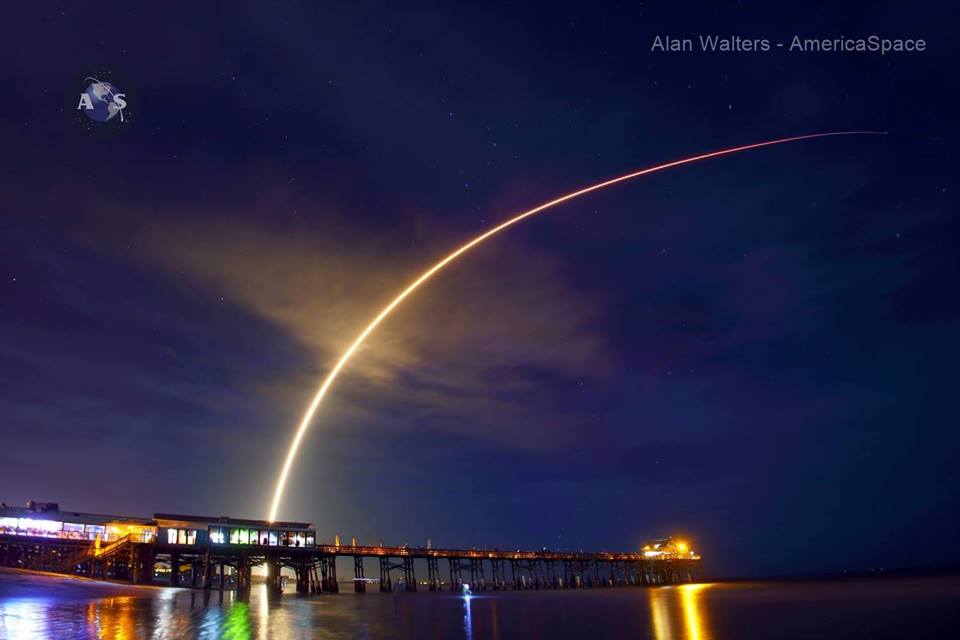
For the first time in its 14-year history, SpaceX has successfully launched an eighth mission within a single calendar year. Its Upgraded Falcon 9 booster—first flown last December—lifted off from Space Launch Complex (SLC)-40 at Cape Canaveral Air Force Station, Fla., at 1:26 a.m. EDT Sunday, 14 August. Roaring into the Florida night under the 1.5 million pounds (680,000 kg) of thrust from its nine Merlin 1D+ first-stage engines, the vehicle was tasked with delivering the heavyweight JCSAT-16 communications satellite into a 22,300-mile (35,700-km) Geostationary Transfer Orbit (GTO) on behalf of Tokyo-based SKY Perfect JSAT Group.
Less than 10 minutes after launch, as the Upgraded Falcon 9’s second stage set to work boosting JCSAT-16 to orbit, the first stage returned under its own power to accomplish a smooth touchdown on the Autonomous Spaceport Drone Ship (ASDS), nicknamed “Of Course I Still Love You.” The latter was located about 420 miles (680 km) off the Cape Canaveral coast, in the Atlantic Ocean. This was the sixth wholly successful landing of Upgraded Falcon 9 first-stage hardware, and the fourth on the drone ship, within the last eight months.
2016 has proven spectacularly successful for SpaceX, as the Hawthorne, Calif.-headquartered launch services company looks back on the disappointment of its first Loss of Vehicle incident in June 2015 and ahead to its pivotal role in NASA’s Commercial Crew ambitions from fall 2017 onward. Since it inaugurated operations with its Upgraded Falcon 9 in December 2015, SpaceX has now flown eight of these boosters, as well as the swansong of its older-specification Falcon 9 v1.1. Putting this into context, the Falcon 9 booster family commenced flight operations back in June 2010, flying twice that year, twice in 2012, three times in 2013, six times in 2014, and seven times—one of which failed to achieve orbit—last year. Over the past six years, the Falcon 9 has moved through its v1.0, v1.1, and into its current Upgraded configurations, as various modifications and the use of the Merlin 1C, Merlin 1D, and Merlin 1D+ engines have been pressed into service.
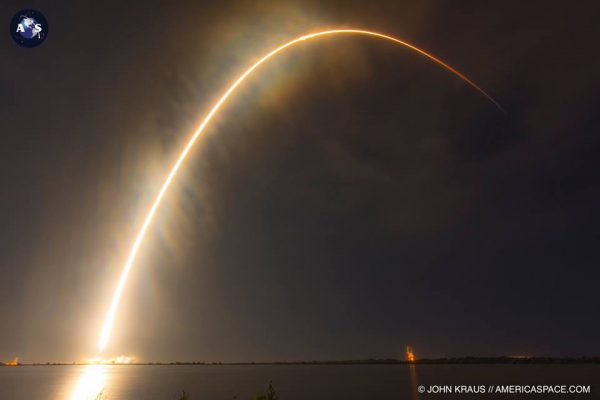
All told, in 2016 alone, the company has delivered NASA’s Jason-3 payload, two Dragon cargo ships toward the International Space Station (ISS), and six commercial communications satellites to GTO. Drawing on the enhanced capabilities of the Upgraded Falcon 9, it has also seen far greater adherence to launch schedules and has seen its first-stage hardware return through the atmosphere to touchdown—fully successfully in 50 percent of cases—on the deck of the ASDS or on solid ground, at Landing Zone (LZ)-1 at the Cape.
Tonight’s launch was the second SKY Perfect JSAT Group satellite to be flown atop a SpaceX vehicle, following JCSAT-14 in May 2016. Both satellites were fabricated by Space Systems/Loral, centered upon the proven SSL-1300 “bus,” with JCSAT-16 scheduled to serve as an on-orbit spare, occupying a “slot” between 124-162 degrees East longitude. From this orbit, it will spend up to 15 years supporting the growing demand for telecommunications infrastructure in the Asia-Pacific Region. Current plans call for JCSAT-15 to fly aboard a European Ariane 5 booster, later in 2016, with contracts also signed earlier this year between SKY Perfect JSAT Group and Lockheed Martin to build JCSAT-17. The launch provider for the latter satellite, targeted to fly after 2019, has yet to be determined.
In readiness for tonight’s launch, JCSAT-16 itself arrived at the Cape in mid-July, where it was fueled and underwent final checks, ahead of encapsulation within the Payload Fairing (PLF) and installation onto the Upgraded Falcon 9. The entire 230-foot-tall (70-meter) booster was transported from its horizontal integration facility to SLC-40 last week, and a customary Static Fire Test of the nine Merlin 1D+ first-stage engines was conducted late Wednesday, 10 August. Successful completion of this milestone allowed SpaceX to press ahead with final flight-readiness meetings, and, with weather conditions expected to reach 80-percent favorable, efforts entered high gear to aim for the opening launch attempt on Sunday morning. For both the primary attempt on Sunday and a backup opportunity on Monday, 15 August, SpaceX had the luxury of a spacious two-hour “window,” extending from 1:26 a.m. through 3:26 a.m. EDT.

Unlike previous Falcon 9s, the Upgraded variant benefits from the capability to late-load its liquid oxygen and rocket-grade kerosene (RP-1) propellants. This does not typically begin until around 35 minutes before T-0. “To gain more power from the rocket, the propellants are chilled-down with the LOX being cooled so much it has a slushy constitution,” noted AmericaSpace’s Launch Tracker. “This supercooling of the fuel means that the fueling must be done at the last minute and indeed it only finishes two minutes before launch. There is very little hold time available once the rocket is fueled, which is why the launch window is shortened once fueling starts.”
As darkness fell over the Space Coast, efforts to prepare the booster and its systems for launch continued. By this point, the weather conditions had improved from 80-percent favorable to 90-percent favorable. At 12:42 a.m. EDT, with around 42 minutes remaining before the opening of tonight’s two-hour launch window, a formal “Go” was issued to begin loading propellants aboard the vehicle. With on-time crispness, RP-1 began flowing into both the first and second stages, followed shortly thereafter by the onset of liquid oxygen tanking into the first stage. By T-20 minutes, liquid oxygen had also begun to flow into the second stage, whose Merlin 1D+ Vacuum engine would support two “burns” to inject JCSAT-16 into GTO. Meanwhile, JCSAT-16 itself was transferred from external power utilities to its on-board batteries, which would power it through ascent until the time came to deploy its electricity-generating solar arrays on-orbit. The SSL satellite was confirmed on internal power at 1:11 a.m.
A final “Go/No-Go” poll of all stations took place at T-13 minutes, allowing flight controllers to move into Terminal Countdown operations at T-10 minutes. During this period, the nine Merlin 1D+ engines were chilled, in order to thermally condition them, ahead of ignition. The launch pad’s “strongback” was retracted, and the Flight Termination System (FTS) was placed onto internal power and armed. Fueling of the booster concluded, and at T-60 seconds the 53 nozzles of the Niagara deluge system flooded SLC-40 with 30,000 gallons (113,500 liters) of water per minute to suppress acoustic energy at T-0.
Precisely on the opening of the launch window, the Upgraded Falcon 9 powered off the pad under the combined impulse of 1.5 million pounds (680,000 kg) from its Merlin 1D+ suite. Eighty seconds into the ascent, the vehicle passed through a period of maximum aerodynamic turbulence on its airframe—colloquially known as “Max Q”—as the engines continued to burn hot and hard. Two-and-a-half minutes after leaving SLC-40, the engines were shutdown and a quartet of pneumatic “pushers” separated the first stage from the stack. Shortly before 1:29 a.m., the second stage’s Merlin 1D+ Vacuum engine, with a propulsive output of 210,000 pounds (92,250 kg), roared to life for the first of its two burns. A minute later, the bulbous PLF was jettisoned, exposing JCSAT-16 to the space environment for the very first time.
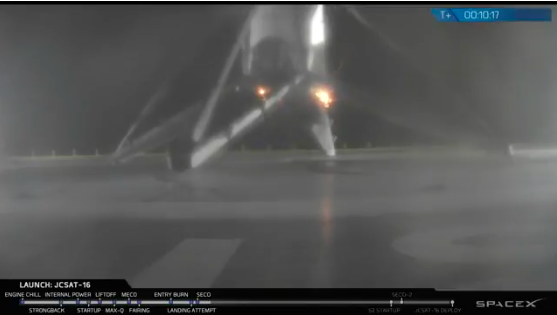
With the second stage well on its way toward delivering SKY Perfect JSAT Group’s bird up to GTO altitude, the discarded first stage began its second mission of the evening: to return from the edge of space and alight smoothly on the deck of the ASDS. Always a complex procedure, and accomplished fully successfully only three times, tonight’s attempt was further complicated by the high-velocity and high-energy demands of its payload. Moreover, previous landing attempts had featured three burns, whereas tonight’s attempt would employ just one. This burn was underway by 1:33 a.m., and the first stage had reached a condition just below the speed of sound around a minute later. Accompanied by spectacular live video from the returning booster, a smooth touchdown on the ASDS was achieved at 1:35 a.m.
Had the ongoing Olympic Games offered an award for such feats, surely SpaceX would have scored Gold, as it nailed its sixth wholly successful landing of an Upgraded Falcon 9. Four smooth ASDS landings were achieved in April, May, June, and July 2016, together with a paid of LZ-1 touchdowns in December 2015 and last month.
As the first stage touched down, dead-center, on the symbolic “X” in the middle of the ASDS deck, the Upgraded Falcon 9’s second stage wrapped up its first burn at 1:35 a.m. and entered a protracted phase of “coasting,” ahead of the second burn. This took place at 1:52 a.m., about 26 minutes and 30 seconds after launch, and ran for barely a minute, before shutting down for the final time. JCSAT-16 was deployed at 32 minutes into the mission, bound for geostationary orbit. Tonight’s mission marked SpaceX’s fifth GTO-bound launch of the year and its sixth overall GTO-bound payload of 2016 deployed. This represents 40 percent of SpaceX’s entire tally of GTO-headed missions within the first eight months of 2016 alone. Next up is the GTO-bound Amos-6 communications satellite for Spacecom, which is tracking an early September flight from SLC-40.
Want to keep up-to-date with all things space? Be sure to “Like” AmericaSpace on Facebook and follow us on Twitter: @AmericaSpace




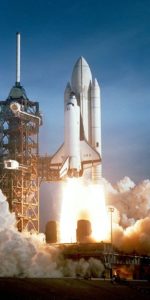
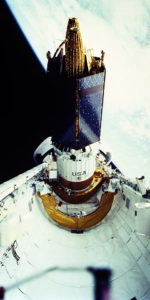
Congratulations to SpaceX, JSat, SSL and USAF for another “Sky Perfect” campaign coming to a close. This is getting a little boring, which btw is the intended/wanted outcome. Now on to Amos-6!
Thanks Ben. BTW, are you chained to the keyboard as it seems that you are carrying most of the load now?
You can tell that SpaceX is now in a groove by the low number of comments on articles, such as this, over the past few months here. I literally never saw a SpaceX article with zero comments as happened of late. Launch rate is up, scrubs are down and a lot less drama on the pad prior to launch. So lets take some stock of where they are…
1) Mid August launch, albeit at night, with no drama around densified LOX. Additionally, many launches with no drama around LOX loading at all. Lots of wasted FUD on that one earlier in the year.
2) JCSAT-14 booster tested at McGregor 3 full duration firings in 3 days. Only moved off the stand to make way for AMOS booster headed to the Cape now. So all the FUD around coking being an insurmountable problem seems to be another waste of energy. We know the booster never left the stand for 3 days and had 3 firings. Hard to imagine how coking could be a real unsolvable problem as suggested. Keep in mind this is the core that did early GTO mission profile return to drone ship. Many people even after Orbcomm2 said GTO stages will be trashed. Well hasn’t flow but still not trash if you can fire it on the test stand over and over again…
3) Landing at the cape is 2:2 with an expectation they land it every time. On the drone ship side, since landing successfully in CRS-8 they are 4:6. This is before the next engine perf upgrade has kicked in later in the year (or early next) to squeeze in a bit more margin and while they are still tuning the GNC approach here.
4) They are moving away from individual engine testing (Merlin1D+) at McGregor and simply testing the engines in the cluster on the stand as they are now seeing very little caught in the initial testing due to manufacturing maturity. This should allow them to ramp production rate of cores even more.
5) Hopefully the pad work finishes at Vandy shortly along with the range work happening there to allow launching again in Sep. Also still waiting on launch hold downs for 39a to be completed. This along with the processes streamlining at McGregor should give them a significantly higher launch rate starting sometime in the back half of the year.
6) Not to mention re-flying some used, not a abused cores. Those are ready to go once the checkout/refurb process is complete. Granted this is still in the dev as no one has really done this before, at this scale, so it will be a huge accomplishment. Sounds from the latest Shotwell comments they may have up to two customers in the near future green light a launch on used F9 booster…
“So all the FUD around coking being an insurmountable problem seems to be another waste of energy. We know the booster never left the stand for 3 days and had 3 firings.”
Hi Clio,
Not going to go over everything point by point as this has been all beaten to death multiple times (another reason the comment count may be down – the back/forth has become repetitive, tedious and unproductive).
There is , however, one point of misinformation in your post that is worth noting.
Speaking for myself only, my “FUD” never said anything (or anything that could be rationally misconstrued as saying) that coking was an “insurmountable problem”. I do not think anyone else did either.
What was said is that coking will add to the cleaning/refurbishment cost for reuse of the Merlin Engines.
Was not clear (and still is not) whether when those costs are completely defined it will make economic sense to attempt to reuse the engines.
Enjoy your weekend.
Well yes the comments were repetitive for a very long time but didn’t seem to stop people rehashing previously…what changed?
No misinformation. If SpaceX can’t deal with coking “economically” it is by definition an insurmountable problem for the entire project. I agree with you that economics in general is the long tent pole and not the technical minutia people having been worried about in the past (Landing legs and LOX loading for example). The fact is we know they can do many full duration firings on the same engines, in place, without disassembly and cleaning. That is a good indicator for choking not being an economic impediment to reuse. We won’t know until we know as the tautology goes. Have a good weekend as well.
I mostly stopped on threads that were clearly not going to resolve. My opinions haven’t changed much, just my attitude towards discussing it here.
Correction in my post before someone else calls me out on it. DPL landings since (inclusive) CRS-8 is 4:5 not 4:6. They lost Eutelsat 117WB/ABS2A booster due to LOX exhaustion right above the deck. Looks like the regular GTO missions are all pretty good now on the ship and mostly need to work on the super-syncs as even Thiacom 8 was a bit dicy.
I am assuming that a core returned from a LEO flight is essentially good to go as is. The jury is out on a GTO core but I see no reason that any and all problems will be resolved and re-use will be going concern in the near future.
The was things are going they best start re-flying lest they soon become awash in used cores. Could be they will be invaluable in launching Mars bound supporting payloads. It will be interesting to hear what Musk has to say next month.
About the middle of the Shuttle Program I began to despair of every seeing anyone on Mars while I was still alive but now, while there are no guarantees, I am hopeful again.
I will have to admit I will miss the FUD guys as I received a kick reading them
Anyone is, of course, free to assume anything they choose.
Best to wait for your (as of now) unsubstantiated assumptions to be proven true (if they are) to being your “victory lap”.
Joe,
Just so I am clear we still do not know the coking issue until the reuse of existing boosters…right?
Hi Tracy,
I do not doubt that some of the Merlin Engines recovered may be able to be reused. But keep in mind reusability is only desirable if it increase safety and/or reduces cost.
The question is how much will the inspection/refurbishment/repair cost and would that reuse be more cost effective than simply using a new first stage?
The coking is one issue involved in that analysis. The Russians have been experimenting with possible designs for reusable rockets and have found that when using kerosene based propellants extensive cleaning (because of coking) is required after a test stand protocol. As a result they are expending money (even with their bad economy) in development of LNG/LOX engines.
Maybe SpaceX will succeed, maybe they will not. We will really not know unless/until they have managed to put the process in place on a routine basis over a period of time and data is available to assess the relative cost. That, of course, assumes SpaceX will share that hypothetical data with others for evaluation.
Why are reusable lighters, for smoking, still around? Why is it desirable to have it when it is more costly, less safe and requires more work to maintain?
Sorry to hear about your nicotine fixation, but since you didn’t notice there are big and significant differences between rockets and lighters.
And between GG cycle and LRSC engines as well…
An excellent example of what I said above about the futility of these “debates
Anyone interested in whether or not coking is a serious issue can read an article on the Russian work I referenced at this link:
http://www.russianspaceweb.com/soyuz5.html
The entire article is interesting and well worth review, but the quote below is specific to the issue that Tracy and were attempting to discuss here before the attempts to deflect the conversation:
“Advantages of methane fuel
… it was established that the replacement of traditional kerosene with liquefied natural gas could produce a higher specific impulse — the key performance characteristic of rocket engines … Moreover, methane would leave no solid residue in the engine’s fuel lines, excluding the need for a laborious cleaning before a new test or the delivery of an already tested engine for installation on the rocket…”
You and Vladislaw can now have a good time arguing the relative merits of reusable vs. expendable cigarette lighters.
I’ve already read this article because you’ve already posted it before.
Here is another article about Russian Methane development:
https://www.rt.com/news/329003-roscosmos-methane-powered-engine/
“We are planning to make a sample methane powered engine, even though there is currently no intention to build rockets that would use such an engine,”
“This way we are planning to stay ahead of the curve and not to be left behind our foreign competitors in terms of technological advances. For now we are talking about creating an average thrust engine for the second stage of the prospective rocket.”
Seems to indicate, along with your article, other reasons for heading down the Methane road besides reuse problems. Not the least of which is American development of staged combustion Methane engines, that are affordable, could put a real dent in Russian dominance in booster engines (regardless of coking issue or not).
Everyone admits Methane is better on soot and coking. So just rehash one article and when new empirical data shows up (3 full duration tests in 3 days) it doesn’t even phase you….don’t even bother to reflect perhaps the article is wrong? Perhaps the circumstances of the statement in the article are narrowly focused to some particulars of those engines? Perhaps SpaceX just found a way to rapidly clean out the lines in situ without much hassle? Who knows but keep pulling up the same article that is hardly dispositive of anything.
When I tried to access your link I get a – This page cannot be displayed notice.
“Seems to indicate, along with your article, other reasons for heading down the Methane road besides reuse problems.”
Both articles indicate that and I never said that coking was the only issue. It is, however, a significant issue; especially if reusability is desired.
In fact even for expendable engines avoiding coking could be an advantage. That is very likely one of the reasons (please note I am saying one of the reasons) ULA is partnering with Blue Origin on the BE-4 Engine for their Vulcan Rocket. Even if they do not try to reuse the engines not having to go through the cleaning process would streamline (reduce the cost) their process flow to get a booster on the pad.
“Perhaps the circumstances of the statement in the article are narrowly focused to some particulars of those engines? Perhaps SpaceX just found a way to rapidly clean out the lines in situ without much hassle?”
Perhaps a lot of things.
Again this back/forth with you is useless. You have your talking points an will not be shaken from them. Do not begrudge you that right, but it would be nice to be able to discuss an issue with out the attempts to deflect the conversation.
Not that it matters, but I will not be responding to anymore of your comments on this subject; so have fun with having the last word (that is your internet rule is it not – he who posts last wins :)).
FWIW, increased coking is associated with increased heat flux. The Russian engines running at over three times the chamber pressure of the Merlin will have on the order of three times the heat flux per unit of wall area. It is possible that the lower performance of the Merlin due to GG cycle and lower operating pressure also reduces the coking to a level acceptable for repeated use.
This is not knowledge on my part, just speculation based on my understanding of the technologies involved.
John,
Thanks for taking a stab at explaining the obvious discrepancy between the claim in the article and empirical reality rather than ignoring it.
Hi John,
Interesting point, but I have no idea how chamber pressure would relate to coking in the fuel lines either.
That is the reason I have always stated my reservations about coking’s effect on refurbishment costs in terms of questions rather than specific numbers.
Also, SpaceX has been going to considerable lengths to improve the Merlin engine performance. Even assuming the speculation to be correct how does that effort effect pump speeds/chamber pressures?
Shotwell has stated that reuse of the first stage would reduce launch cost by 30% if no refurbishment of any kind is required.
That is the point.
It is difficult to believe there will be no need for “coking cleaning” at some interval and other inspections/refurbishment as well (structural fatigue etc.).
If the stage can in fact be reused at all the question is how much will those activities reduce that 30% figure. Maybe it will be by less than the 30% maybe not (could be – counter intuitively – more expensive to reuse the stage), it is not assured that even SpaceX knows that at this point.
That was the point of my original post to Tracy:
“We will really not know unless/until they have managed to put the process in place on a routine basis over a period of time and data is available to assess the relative cost. That, of course, assumes SpaceX will share that hypothetical data with others for evaluation.”
That was, of course, before the discussion got side tracked into the more important discussion of reusable vs. expendable cigarette lighters.
Thanks Joe, I am surprised that we have not had a reuse yet of a returned booster..You?
Hi Tracy,
No I am not surprised.
As referenced in my post to you (way) above there are a wide range of things that should be checked out before attempting to reuse a booster including, but not limited to potential coking problems.
Just to pick one additional example in the area of structural integrity, SpaceX says that the CRS-7 was lost due to the failure of a defective strut. That was on the second stage, but they also said these types of struts were used in many places in the vehicle. What are the conditions of these (presumably) non defective struts after experiencing the launch/landing environment. The failed strut in CRS-7 was located inside the LOX tank, so inspecting/evaluating these struts is not a trivial task.
That and any coking inspections are just two of a long list of areas to be checked.
As far as I know SpaceX has not said, but I will give them the benefit of the doubt and assume they are taking their time and doing a careful and methodical examination of the returned stages before committing to trying to re-fly one.
As always, a great strawman you created and then knocked down Joe.
“But keep in mind reusability is only desirable if it increase safety and/or reduces cost.”
You said I was to keep in mind that reusablity, which you didn’t define but said in general terms, is “ONLY” desirable. Like Moses coming down from mount sinai clutching your stone tablets issue the Law of Joe.
There can be other reasons for reusablity. That was the only point.
Actually the comment was to Tracy not you.
However, as long as you bring it up:
If reusability does not increase safety and/or decrease why do you feel it is desirable?
More NewSpace roboposting nonsense from Coastal Ron. The anointed one may have cashed in on his secret golden handshake with Obama but he cant change the laws of physics. The rocket equation says no. He will never land his rockets and reuse them.
Gary Church was actually Coastal Ron making statements to attract attention to SpaceX.
Gary,
I ran across something about “wet workshop”
http://www.prnewswire.com/news-releases/ixion-initiative-team-wins-nasa-award-to-study-the-conversion-of-rocket-upper-stages-into-habitats-for-use-in-leo-and-beyond-590048741.html
And I thought of you…Isn’t this what you have been advocating for? Also why is nobody rotating their ships to generate an artificial gravity?
Tracy,
That can’t possibly be the real “Gary Church” although quite a humorous display of his previous prognostications.
Tracy the Troll –
“Also why is nobody rotating their ships to generate an artificial gravity?”
Everything put into orbit costs lots of money.
The problem is that large “rotating ships” with a lots of effective radiation shielding are much heavier and thus cost much more than smaller non-rotating spaceships with inadequate amounts of radiation shielding.
‘Mars Now and on the Cheap’ is what is currently being sold.
Maintaining the good health of our astronauts with heavy “rotating ships” and effective radiation shielding seems to mean zip to those who would rather spend money elsewhere.
“Data from Curiosity’s Radiation Assessment Detector (RAD) show that science astronauts on a Mars landing mission in the mid 2030s would experience radiation levels that cause a significant increase in risk of death by cancer.”
And, “Because the opportunity to transit to Mars occur only at infrequent intervals, a typical mission in 2037 (NASA Design Reference Architecture 5.0) would involve a Mars stay of 539 days, an outbound trip of 174 days, and a return trip of 201 days. RAD has measured a transit dose-equivalent rate of 1.84 milliSieverts per day (mS/day) and a Mars surface dose-equivalent rate of 0.64 mS/day. This indicates a total Mars mission dose of 1,035 mS. Long-term population studies have shown that a radiation dose of 1,000 mS increases a person’s lifetime fatal cancer risk by 5 percent.”
From: ‘Radiation Threat To Martian Spaceflight’ February 12, 2014
At: http://www.seti-setr.org/TIST/radiation_threat.html
The Moon is nearby and doable for astronauts who can retain their good health because six meters of Lunar dirt is readily available everywhere for use as effective radiation shielding. And the Moon’s 1/6 gravity is a useful bonus health benefit.
Where are we going next?
The Moon.
James,
How long do you think it will be before someone creates a ship with an artificial gravity rotation? I mean this is an Apollo era concepts, and suddenly NASA is making claims now on the effects of long term weightlessness in the ISS after the Kelly Twin studies..
Tracy the Troll –
“How long do you think it will be before someone creates a ship with an artificial gravity rotation?”
It could be done in ten years. Build it at the ISS. Test it in orbit around the Moon. Load up with propellant from the Moon and go explore. Fly it to Mars and Ceres. Keep on building such ships at the ISS. Get everyone on the planet involved.
‘All’ it takes is lots of money and some smart leaders…
In defense of the politicians, they know there are a lot of Baby Boomers that will need quite a bit of expensive social services during the next 20 to 30 years…
Given the givens, including the slide into a new Cold War, it may be several decades “before someone creates a ship with an artificial gravity rotation”.
Looks like that 5 1/2 month regroup, after the loss of CRS-7, for SpaceX, was a gold mine. They have come out smoking ever since. Soon NASA will have available to it, its own beginner Star Fleet consisting of 3 crew vehicles and 3 cargo vehicles.
“Star Fleet” represents lots of folks and includes the Soyuz, Shenzhou, and Kounotori HTV spacecraft and lots of launchers.
“The China National Space Administration offers NASA the “Tai Yang Shen”(太阳神, the God of Sun), a classified booster rocket that can carry a payload to Mars. Meanwhile, JPL astrodynamicist Rich Purnell devises a trajectory to send Hermes back to Mars more quickly, using the Chinese booster to instead resupply it for an additional eighteen months.”
And, “The film was released in 2D, 3D, IMAX 3D and 4DX.[5] It received positive reviews and has grossed over $630 million worldwide, becoming Scott’s highest-grossing film to date, as well as the tenth-highest-grossing film of 2015.”
From: ‘The Martian (film)’ Wikipedia
At: https://en.wikipedia.org/wiki/The_Martian_(film)
“Star Fleet” needs everyone.